Final report for FS17-297
Project Information
- Haemonchus contortus continues to be a limiting factor on sheep production for small scale producers in the United States using a pasture based system. Hot and humid summer climate in the Southeastern US provide optimum conditions for H. contortus to develop from eggs deposited in feces to L2 and L3 larvae on warm and moist pastures. The current commercially available anthelmintics are becoming ineffective in many areas due to years of systematic deworming practices used by sheep and goat producers.
New classes of anthelmintic are not being developed by pharmaceutical companies. Sustainable farming practices such as rotational grazing, use of FAMACHA scoring and administering copper oxide wire particles (COWP) as a bolus aids producers who wish to avoid using chemicals to treat animals destined for market or those wishing to use organic husbandry. However, even using a rotational grazing system, FAMACHA and COWP, producers continue to have losses from parasitic infections.
Traditional internal worm strategies have focused on control through pharmaceutical anthelmintics. More recent internal strategies include COWP and use of tannin rich forages to disrupt the parasite life cycle. External strategies to control H. contortus have been limited to dry lot feeding and rotational grazing. Additional external control strategies are needed to reduce the larvae that develop on pasture.
Our project tested the theory that a naturally occurring bacteria, Bacillius thuringiensis (Bt), could be used as a larvacidal when applied to pasture/forage during a rotational rest period to find if it would be effective in reducing L3 larvae available for animal uptake. Biological agents such as Bt are considered to be organic control if they are one of the naturally occurring strains of bacterium.
By spraying liquid Bt or spreading Bt granules on a pasture or paddock that recently had animals rotated off, our goal was to reduce larvae populations in the L2 and L3 stages making them unavailable for uptake by sheep once the animals are rotated back into the paddock during rotations.
The project spanned 28 weeks during the Spring/Summer/Fall of 2017 and data is divided into three phases; a pre-test, Phase 1 and Phase 2. During the pre-test phase (3-weeks) the lambs lived in a corral dry-lot and did not rotate while they were trained to stay within the electric fence that was used during Phase 1 and 2. Phase 1 (18-weeks) consisted of 3 full rotations through a six paddock field that was sprayed with liquid Bt. Phase 1 was not successful in showing a reduction in L3 available as evidenced by no difference between the control group and the treatment group. Phase 2 (6-weeks) was a full rotation through the 6 paddock field that was sprayed with liquid Bt as before and additionally the treatment group was fed a small quantity of Bt daily during Phase 2. During Phase 2 there was a statistically significant difference between the control group and the treatment group with a reduction in fecal egg counts (FEC) in the treatment group.
For sheep farmer who desire to produce an organic carcass or those who wish to limit chemical inputs in their animals options are limited to COWP and tannin rich forages.
Naturally occurring bacterium such as Bacillus thuringiensis (Bt) has been used by organic gardeners to control many species and sub-species of caterpillar and other insect larvae from damaging plants and crops. Bt works by encoding toxins that kill target species of insect larvae. The bacteria forms crystal protein toxins which when ingested by the larvae transform and attach in the gut of the larvae forming a pore. The larvae then fails to eat and starves thereby breaking the lifecycle.
Bacillus thuringiensis variant Israelenis and variant Kurstaki have been tested as a larvacidal on sheep feces and found to be effective at reducing larval populations.
By using a rotational grazing system, producers move animals from pastures where manure and potential Haemonchus contortus eggs have been deposited when grazing heights fall below set limits to maximize forage use and reduce the risk of worm infection. However, pastures can still remain infected by parasites waiting to complete the lifecycle when animals are rotated back onto pastures. Rotational grazing seeks to move animals before forage is grazed down near the ground where L3 larvae can survive in warm moist conditions.
By spraying liquid Bt or spreading Bt granules on a pasture or paddock that has recently had animals rotated off, we seek to reduce larvae populations in the L2 and L3 stages making them unavailable for uptake by sheep once the animals are rotated back onto the paddock during rotations.
Cooperators
- (Educator)
Research
In-Processing
Twenty-four recently weaned Dorper sheep (ages 10-16 weeks; average weight approximately 50 lbs [range 40-60 lbs]) were purchased from a single farm in Missouri. Twelve ewe lambs and 12 ram lambs arrived April 7, 2017 and were corralled overnight. On April 8, 2017, we in-processed the lambs - the 12 female and 12 male lambs were randomly selected into one of four test groups so that each of the four test groups had six lambs with equal number of males and females. Lambs were re-tagged with colored eartags representing their study group and numbered 001-024.
- Group 1 (Green tags #001-006)
- Group 2 (Red tags #007-012)
- Group 3 (Blue tags #013-018)
- Group 4 (White tags #019-024)
All lambs were weighed and FAMACHA scoring was performed and scores were recorded. All lambs had Body Condition Scores (BCS) measured and recorded. A baseline fecal sample was collected and all 24 lambs were dewormed with Zimecterin Gold paste horse dewormer (active ingredients: Ivermectin 1.55% and Praziquantel 7.75%) given based on weight for 50 lbs as directed per package instructions This was done to remove any existing GIN infection from Missouri and allow native Haemonchus contortus populations to reinfect under local conditions during a three week reinfection period.
On In-processing day, as the lambs were tagged, weighed, scored, de-wormed and samples collected. We administered co-pasure copper oxide wire particles (COWP) to two of the groups, Groups 1 and 3. Groups 2 and 4 received no bolus. The matrix below shows the 4 groups.
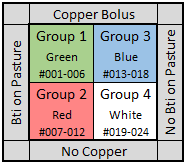
Group 1 - green tags #001-006 [CuBT; n=6] Six lambs received a 2g bolus of COWP orally during in-processing. Group 2 - red tags #007-012 [BT; n=6] received no copper bolus. Both Group 1 and 2 rotated together on dedicated pasture together to test the theory that Bt sprayed on the pasture would reduce larvae available for uptake during grazing. They are the Group 1/2 or Bt Group.
Group 3 - blue tags #013-018 [Cu; n=6] Six lambs received a 2g bolus of COWP orally during in-processing. Group 4 - white tags #019-024 [CON; n=6] received no copper bolus. Both Group 3 and 4 rotated together on dedicated pasture that was not sprayed with Bt. Group 4 is the control group with no copper and no access to Bt sprayed pasture. They are the Group 3/4 or the Control Group.
On April 13, 2017 our veterinarian came to the farm and drew blood samples to determine a baseline Packed Cell Volume (PCV) before the study rotations began.
Pre-Test Period
For a three week pre-test period, we corralled all 24 lambs together in a small area where adult sheep had been housed. Study lambs were allowed to eat grass to low levels to assure they would graze down to levels where existing worm larvae would be found. The 24 lambs had access to a small side pasture each day for training with electric fencing so they could follow the rotation during the study period.
The pre-test period also allowed for the lambs to adjust to the native grasses and water supply. This rumen "reset" was important to allow the lambs to respond to the living conditions experienced in southern Tennessee.
At the conclusion of the pre-test period, the two larger groupings of lambs (Groups 1 & 2, known as the Bt or Treatment group and Groups 3 & 4, known as the Control group) were sorted and sent to their respective paddocks to begin Phase 1.
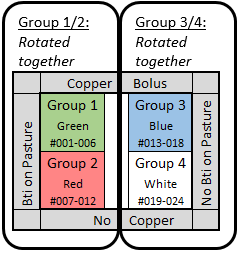
Each of the two larger groupings had dedicated pasture and a dedicated waterer and did not have access to the other group during the study. The two groups were not recombined until after completion of Phase 2 and the study completed.
Phase 1
Phase 1 consisted of three complete rotations around a central waterer. Six, approximately 1/2 acre, paddocks were used for each larger group. The groups were confined to a single acre using polywire and step-in posts for one week and grazed that acre exclusively. Each week the larger groupings rotated around the waterer until they completed a rotation. A full rotation took six weeks to complete. Due to this rotation formula, each 1/2 acre rested for five weeks (35 days) before the lambs rotated back onto a given paddock. In a true rotational grazing system, we would not have rotated lambs back onto a pasture after a 35 day rest as worm larvae would still be high at that time. However, for the study we wanted to see if spraying Bt on the pasture had any effect on worm load. The map below shows an aerial view of the Harris Farm. Treatment Group (1/2) are shown in yellow and rotated around a central waterer (green "W") with a 10' gravel pad surrounding it. Each 1/2 acre paddock is numbered and lambs rotated around the waterer in the order shown on the map beginning at circle #1 and completing a rotation at paddock circle #6. The lambs then began the rotation again - completing four rotations during the study, three during Phase 1 and one rotation during Phase 2. The Control group (3/4) is shown in Blue and had an identical waterer and gravel pad. Likewise, their 1/2 acre paddocks are numbered circle #1 to #6 and they rotated in the same manner, also competing four rotations during the study. Near each waterer, we constructed a working pen to collect fecal samples weekly. The working pens are not shown on the map.
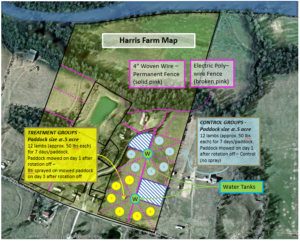
As Groups 1 & 2, known as the Bt or Treatment group were rotated off their paddock each week, we bush-hogged the acre and sprayed a Bt solution made with water and Gnatrol WDG Biological Larvicide Bacillus thuringiensis, subsp. israelensis, strain AM 65-52 at the rate of 2.47 billion spores per acre. When possible the solution was sprayed at dusk or dawn to take advantage of higher ground moisture and allow the Bt to remain on the grass and soil before light and higher temperatures begin degrading the effectiveness of the Bt spores. The non-Bt paddock where Groups 3/4 rotated off was also bush-hogged to the same height as the Bt paddock. In retrospect we should have sprayed plain water on the non-Bt paddocks to account for the added moisture the Bt paddock received during spraying but we only had one sprayer and it contained Bt residue.
Each week during the rotation to the next paddock, all 24 lambs were weighed, fecal samples collected and FECs performed, BCS were measured and recorded and FAMACHA scores were recorded. Every 30 days or so, our veterinarian made a site visit to collect blood to perform PCVs to gauge parasite infections resulting in anemia. Each month we created a pooled fecal sample from the same collected fecal material from each of the four groupings and took to our veterinarian for his staff to run independent verification of the group FEC average.
The metrics were used to help determine the need for salvage deworming during the study with FECs, FAMACHA score and PCVs holding greater value in determining the need to deworm or give treatment.
During the third rotation of Phase 1, paddock forage growth slowed due to summer heat, lambs in all groups stopped gaining weight and we decided to offer a pellet and grain mixture once per day in addition to grazing. The 12 lambs in Group 1/2 and the 12 lambs in Group 3/4 ate from common feed pans at their respective central waterer each day for an evening meal. As the lambs in each grouping ate from common feed pans it was not possible to determine how much each lamb ate, but it was offered at a rate of .75 lbs/day.
Phase 2
In early September 2017, we began Phase 2 of the study. In noting no discernable differences in the metrics between Group 1/2 (Bt group) and Group 3/4 (Control group) we began feeding dry Bt spores in the daily feeding to the Bt group only. Dry Bt was added to the feed cans at a rate of 8 grams per day. As in the case with feed - it was not possible to determine how much each lamb ate of the Bt spores but it was assumed to be .5-.75 grams/day (12-18 million spores per lamb).
End of the Study Period
The data collection concluded on October 14, 2017 and the two groups of sheep were combined and moved from the study pasture. Condition, weight gain and parasite infection levels were measured in Dorper Lambs.
Bti and the Effect on Fecal Egg Count Measures
Bti - Sprayed on Pasture
We determined during Phase 1 that Bti was ineffective at keeping larvae numbers reduced and unavailable for uptake by the lambs grazing the paddocks sprayed with a Bti solution as evidenced by the weekly FEC measurements. FECs that were reduced or zero during the three week pre-test period began increase steadily once the lambs began their rotations and by Week 8 two lambs from the Treatment group, G-006 and R-012, were at high levels (10,500 epg and 11,750 epg respectively). Those two lambs were salvage dewormed. At the week 8 measurements average FEC for all lambs was 4,998 epg. The table below shows the group averages for in-processing and Rotation 1.

After deworming, the Red and Green group averages decreased. The graph below shows the climb in FEC after grazing the worm infested corral for three weeks. By three weeks, eggs ingested in the corral were at the adult stage and beginning to produce eggs.
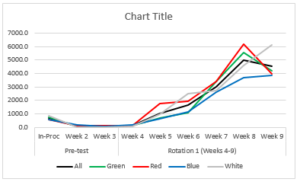
By week 10 and beginning the second rotation, an additional three lambs approached FECs of 10K (R-008, B-014 and W-023) with five additional lambs near 7-8K. In week 10, all lambs were dewormed.
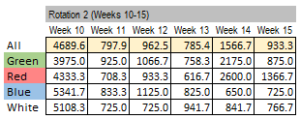
On our farm, our practice is to not deworm an entire group of animals, but we also did not want to start losing animals from the study. As week 10 began, the first week that lambs in the treatment group would be exposed to the paddocks sprayed after bush-hogging during the first rotation, we felt safe that de-worming again would not affect the results of the study. Below is a graph of the FECs during the second rotation showing the reduction in FECs after week 10. FECs in week 11 show some resistance to the de-wormer.
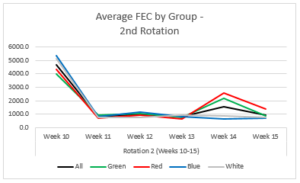
In week 16, lamb R-010 spiked to 15,650 epg and it was dewormed and three weeks later, Week 19, R-010 was once again above 10K (11,800 epg) and was de-wormed again.
In addition to the salvage de-wormings on individual lambs and repeat de-worming of the whole flock in week 10, during week 19, PCV values for nine lambs fell below 24%. The range of PCVs in the nine lambs was 12-22% with an average of 18.8%. For those nine lambs, we administered 5mL of pig iron IM. The remaining 15 lambs averaged a PCV of 29% with a range of 24-40% and no iron was given to the remaining lambs. The table below shows the PCVs for each lamb during the study. The April measurement was taken during the first week, while the lambs were in the corral and is considered their initial value.
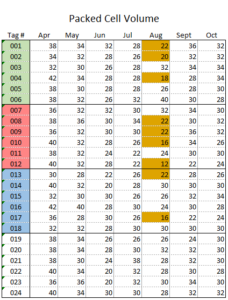
The table below shows the group averages for PCVs.

As summer progressed, paddock quality reduced, due to inadequate rain, to the point that we began to record some weight losses at Week 12 during Rotation 2. By week 15, we made the decision to supplement feed a pellet and grain mixture to help maintain weight. We began a daily evening feeding of 8-10lbs of feed per group. This equated to approximately .75 lbs per sheep. Both the Bti Treatment group and the Control group received the supplemental feed. And while weights jumped initially, the weights soon stagnated again. Rotation 3 shows small gains in all groups. The Table below shows the average weights by group in Rotation 3.
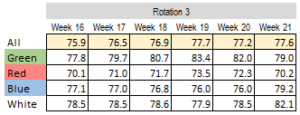
The following graph shows weight gains by groups during the third rotation.
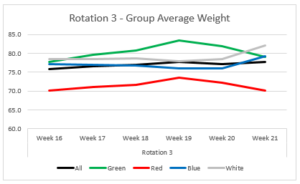
Bti - As a Feed Additive
By the end of Rotation 3, the Bt Treatment group showed no significant difference (p<0.05) from the Control group for FECs. And after the third rotation, we began to add 8 grams of Bti granules to the feed can at the evening feeding for the Bt Group. It is not determinable to know the quantity of Bti ingested by each Treatment group lamb, but it is assumed to be .5-.75 grams of Bti per lamb per day.
Results of feeding Bt to the Treatment group resulted in a significant (p<.05) reduction in FECs. The resulting drop is shown in the table below.
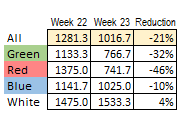
The following table gives the group averages for FECs during the Rotation 4 where the Bti Treatment group was fed Bti spores once daily. The post-study measure was performed as animals were moved off the study pastures and merged back together at the conclusion of the rotation off the sixth paddock. The Treatment groups 1/2 (Green and Red) showed reductions in their FECs over the fourth rotation of 55% and 56%, respectively, where as, Control groups 3/4 (Blue and White) also had reductions in FEC of 13% and 45%, respectively.
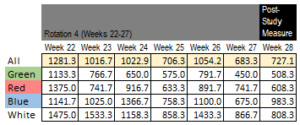
The following graph shows the reduced FECs for group averages during the fourth rotation and the Post-Study Measure.
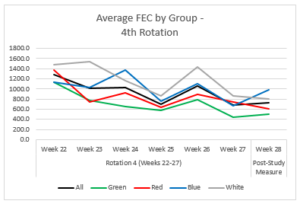
It was unclear to us why the Control group also had reduced FEC as the fourth rotation progressed and we made the assumption that as cooler weather moved into the area that adult worms went into hyperbiosis or fewer eggs were being taken in from the pastures resulting in fewer adults to lay eggs.
Effects of COWP Bolus Given to Lambs on Pasture
Groups 1 (Green) and 3 (Blue) were given a 2g Copper Oxide Wire Particle bolus at in-processing to gauge the effects and verify that it would suppress FEC values. The table below shows a reduction in FECs for Groups 1 and 3 for approximately five weeks. The lambs treated with the copper bolus had FECs that were 1/2 the values of the non-COWP bolused lambs. The box drawn around the averages for the groups broken out by Copper and No Copper lambs show the time period where FECs were reduced in the COWP'd lambs. After five weeks both the COWP'd lambs and the non-COWP'd lambs had similar FECs.
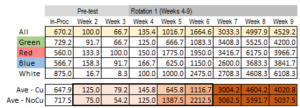
Other Concerns
The statistics for the Red group (#007-012) were poorer in most categories due to the performance of the three female lambs from the group. The following three charts (R-008, R-010 and R-012) illustrate the performance issues with these three lambs. Each were below the group average for weight and weight gain, had higher than average FECs, need additional salvage de-wormings and attained life threateningly low PCVs. The graphs detail the lamb's performance for weight against the Red group average, the average for all females and the overall group average. Shaded portion behind the lines represent the max and min values for weight for the female population. A gold box is drawn around the period the lamb was fed Bti and red arrows indicate an intervention via de-worming for the lamb, while an orange arrow indicates administration of iron.
As shown in the chart for R-010, this female lamb in the Bti group - no copper, is the min weight value for most of the study for all female lambs. The bottom portion of the chart details the values for each metric for In-processing through Week 28. Green shading of the values denote a favorable value, no shading of the value is an acceptable value and shades of red denote unfavorable. With darker shades of red being more unfavorable than a light shade of red. Black or gray values are bad. The 1-week average gains schema are similar, in that green is good, yellow is middle ground and red is undesirable. The large arrow at the bottom indicates if the lamb is improving, holding steady or declining in measurements.
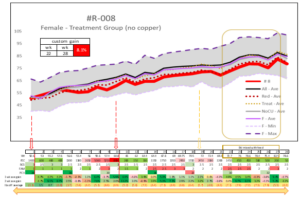
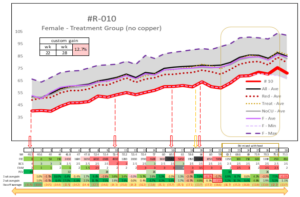
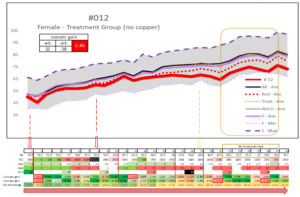
Concluding Thoughts
Although we felt that Bti sprayed on pasture was ineffective, we did find some success in feeding Bti granules to the lambs to combat Haemonchus contortus. We feel further study in this area is necessary to find the correct quantity and timing of Bti when fed. Additionally, we did see short-lived reduction in FEC with the use of COWP (approximately 5 weeks after administration).
Educational & Outreach Activities
Participation Summary:
On July 27, 2018 our farm presented the results of our study before the membership of the Mid-South Regional Dorper Association during the events at their annual meeting. The meeting is held during the Southern States Dorper Show and Sale. The show and sale are attended by farmers from all over the United States buy largely by those members and Dorper owners from the southeast. It was attended by approximately 20 farms with 30-35 people in attendance. The presentation was well received and we had a lengthy question and answer period to field questions from participants.
Additional outreach activities included inquiring to Dr. Maria Leiting-Browning of Alabama A&M and ACES of co-hosting a joint event during one of the ACES planned activities for small ruminants that ACES hosts.
Our farm also provided an on farm tour and description of the study to several other sheep and goat producers who visited the farm to purchase animals.
Learning Outcomes
Many of the farmers who gained knowledge remarked on their increased understanding of the worm life cycle and how to break the cycle using rotational grazing, rest periods for pastures and understanding the link between the worm life cycle - temperature - moisture levels. Many participants learned new terminology including hypobiosis, refugia, resistance and resilience. Learning how Haemonchus contortus grows and thrives and what can be done to disrupt the life cycle will help producers and owners combat Haemonchus contortus infections.
Several participants gained understanding of and also reported a better understanding of how to perform a fecal egg count using a McMaster slide and why it is important to monitor your animals using FAMACHA and FECs.
Participants were made aware of the SARE searchable data-base of studies on various issues relating to ruminants.